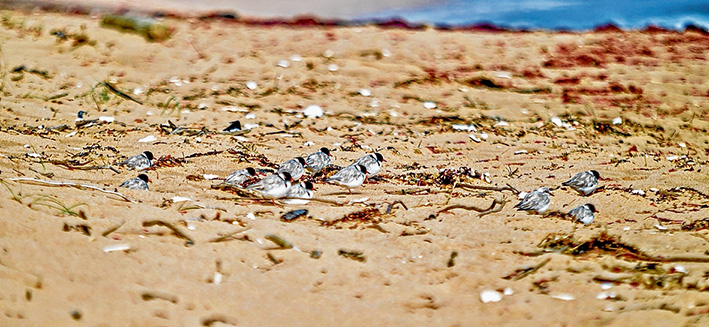
GOOD news for the endangered hooded plover and other species last week with environment minister and Flinders MP Greg Hunt announcing a five-year threatened species strategy that will see $6.6 million spent on killing two million feral cats and creating new safe havens for native animals.
It is an attempt to save 20 mammal, 20 bird and 30 plant species at risk of extinction.
On the bird list is the hooded plover, which breeds in South Australia and Victoria, including on Mornington Peninsula beaches and foreshores where just four birds out of 150 eggs survived to flying stage during the 2014-15 breeding season.
There are fewer than 600 hooded plovers left in Victoria.
The announcement came a week after The News reported that the final two hooded plover chicks to hatch on the peninsula this season died just days before they were able to fly, one killed by a dog and one by drowning, possibly frightened into the water when its mate was attacked. The first death was confirmed by an autopsy done at Deakin University.
Mr Hunt announced the plan at a threatened species conference at Melbourne Zoo last Thursday where he said: “We are drawing a line in the sand today which says ‘on our watch, in our time, no more species extinction’.”
The first 12 mammals are the numbat, mala, mountain pygmy-possum, greater bilby, golden bandicoot, brush-tailed rabbit-rat, eastern bettong, western quoll, Kangaroo Island dunnart, eastern barred bandicoot, leadbeater’s possum (Victoria’s faunal emblem) and central rock-rat.
Mr Hunt announced a list of 12 birds to benefit from “priority action”. “I want to bring these birds back far enough from the brink to survive in the wild long-term.”
They are the helmeted honeyeater (Victoria’s bird emblem), hooded plover, eastern bristlebird, regent honeyeater, Mallee emu-wren, plains-wanderer, night parrot, Alligator Rivers yellow chat, Norfolk Island’s green parrot and boobook owl.
“The orange-bellied parrot and western ground parrot will benefit from emergency interventions,” Mr Hunt said.
The remaining eight species of mammals and eight species of birds will be identified over the next 12 months in consultation with the community, Mr Hunt said.
Last month Mr Hunt ordered his Threatened Species Commissioner Gregory Andrews to prepare an “urgent strategic response” to deal with a disease that threatens to decimate the last 50 orange-bellied parrots in the wild.
Two-thirds of 30 birds born in the wild last summer in Tasmania have been diagnosed with common beak and feather disease, also known as Psittacine Beak and Feather Disease, which can kill young birds and adults with a weak immune system.
This is the parrot that once graced the saltmarsh shores of Western Port and became famous as a political football when its endangered status was blamed for delaying a wind farm in Gippsland in 2006 and the proposed marina expansion at Yaringa boat harbour near Somerville in 2012. It is sometimes seen at the Western Treatment Plant near Werribee but has not been seen on the peninsula since 1987.
The threatened species plan has received a cautious welcome from environment groups given that the federal government is in the process of handing powers associated with the federal Environmental Protection & Biodiversity Conservation Act to the states, which many have said will weaken environmental protection.
The government has also removed all funding from the Australian Environmental Defenders Office, a network of public interest lawyers that supports the work of environment groups.
Mr Hunt said all states and territories had agreed to list the feral cat as a harmful pest. Two million will be killed by 2020 by shooting or poisoning.
Some groups said $6.6 million was not enough and questioned the lack of any stricter controls on habitat loss.
Kelly O’Shanassy of the Australian Conservation Foundation urged the government to commit more money. “Threatened species recovery work is run on the smell of an oily rag. The new money is welcome, but funding remains inadequate,” she said.
“The strategy also fails to meaningfully address the biggest threat to threatened species and ecological communities – the loss and fragmentation of habitat – either through investment in new protected areas or by safeguarding existing critical places.”
First published in the Southern Peninsula News – 21 July 2015

